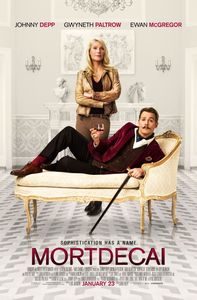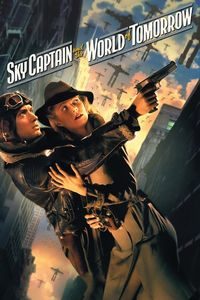(In theaters, September 2004) Every two or three years, sci-fi geeks get a little present from Hollywood. Dark City, Equilibrium and now, Sky Captain And The World Of Tomorrow. They have to be quick, though: The films usually crash and burn with nary a trace, proof that what turns on geeks like myself is just not what amuses mundanes. Oh, it’s not like this is a perfect film, even for pre-sold audiences: Shot in a virtual environment, it has all the stiffness of old studio films. Interaction between characters and stage are reduced to a strict minimum, and there’s an aura of artificiality clogging the naturalism of the direction. The self-consciously pulpish story may not be to everyone’s taste, but even the best intentions can’t compensate for lengthy stretches of banal dialogue. This being said, nothing will stop me from loving this film unconditionally; it’s simply a beautiful piece of nostalgic golden-era SF, filled with big images and classic themes, wonderful machines and crazy ideas. I’m not usually a big fan of Gwyneth Paltrow, but it just takes long flowing locks of blonde hair and a sassy attitude to show me the error of my ways. Yes, this is a box-office flop and an incomprehensible curiosity to mass audience. But I’ll be buying the DVD as soon as it comes out; thank you Hollywood, and I’ll wait until the next happy accident.
(Streaming, May 2025) Twenty years later, Sky Captain And The World Of Tomorrow remains sui generis — writer-director Kerry Conran never managed to parlay the buzz around his achievement into a Hollywood career (although he says he’s working on things), and blockbuster effects-driven movies rarely swung as hard for the fences as this early example of all-digital filmmaking. But the film remains a success on at least three fronts — it’s still hugely fun to watch, it’s has become a bit of a cult movie for retro-SF fans, and the innovations pioneered here can still be heard echoing in more recent films and TV shows (think StageCraft’s The Volume) where nearly everything is animated except for the actors. And it works! Despite some stiffness (intentional), occasionally dodgy effects (inevitable) and uneven dialogue (unfortunate), it’s a wonderfully imaginative film on a visual level, and it lives by the ethos of showing something cool every few minutes. Jude Law makes for a perfectly cocky hero, and Gwyneth Paltrow has seldom looked better. If you listen to the commentary tracks, make sure to listen to producer Jon Avnet’s one before the one with writer-director Conran: Avnet’s track is a complete and often very honest account of the six years he spend on this unlikely project, and it’s tinged with affection for the film. In contrast, the disappointing Conran track is sparse, often trivial (“this was the first scene we shot… we built a set of this”) and barely hints at the passion project that this film was. It’s not enough to make anyone watch the film another time, but the Avnet one will.









